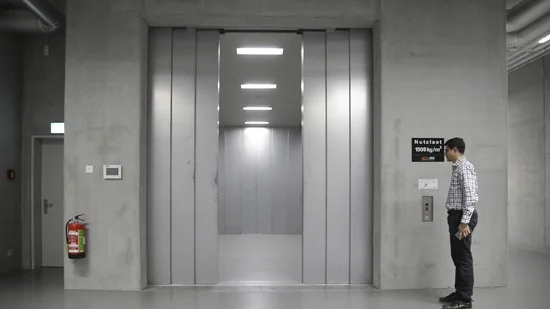Uncovering the secrets of the hydraulic lift
Hydraulic lifts, such as the OLYMPUS, are a cornerstone of modern vertical transportation systems. When implemented effectively, they provide efficient movement in various settings, from warehouses to commercial buildings.
At the heart of their functionality lies the principle of hydraulics, as a reliable method for transferring force using fluid pressure. Here, we'll delve into how hydraulic lifts work, exploring their mechanisms and applications, while also highlighting instances where alternatives like the Sherpa lift system may offer advantages.
How hydraulic lifts work
Hydraulic lifts operate on the foundational principle of Pascal's Law, which is a fundamental concept in fluid mechanics. According to Pascal's Law, pressure exerted on a confined fluid is transmitted uniformly throughout the fluid in all directions.
This principle forms the basis of hydraulic systems, where the application of force at one point in the fluid results in an equal force transmitted to another point within the system.
In the context of hydraulic lifts, Pascal's Law enables the amplification of force. This allows a small force applied to a small area to generate a significantly larger force over a larger area. This amplification of force is crucial for lifting heavy loads efficiently and effectively.
So, in a typical hydraulic lift set up, here's how the process will actually work:
- Starting the Lift: An electric motor turns a pump which pulls hydraulic fluid (usually oil) from a reservoir.
- Pressurising the Fluid: The pump forces the fluid into a cylinder, increasing its pressure.
- Lifting Action: The pressurised fluid pushes against a piston inside the cylinder. This piston is connected to the lift platform, causing it to move upward.
- Descending Process: A valve is opened to release the pressurised fluid back into the reservoir. The weight of the platform and its load forces the piston down.
What are the Components of a hydraulic lift?
Each component in a hydraulic lift plays a crucial role in its operation, and makes sure that its movement remains smooth.
These are the essential parts of a hydraulic lift system:
- Hydraulic fluid: The liquid that transfers pressure in the system.
- Piston: The cylindrical part within the cylinder, moved by the fluid's force.
- Cylinder: The tube that contains the piston and fluid.
- Control mechanisms: These may include valves, switches, and sensors that manage movement and speed.
What are the safety features of a hydraulic lift?
Safety is paramount in hydraulic lift systems to protect both personnel and property from potential hazards. Various safety features are integrated into these systems to mitigate risks and ensure secure operation.
Firstly, pressure relief valves play a crucial role in safeguarding the hydraulic system. These valves are designed to prevent damage by limiting the maximum pressure.
Another vital safety feature is safety interlocks, which are mechanisms designed to prevent the lift from moving under unsafe conditions. These interlocks may include sensors or switches that detect hazards such as obstructions or malfunctions..
Additionally, overload sensors are designed to detect when the lift is carrying too much weight beyond its specified capacity. Once an overload is detected, the sensors trigger mechanisms to stop the lift from operating further.
Where are hydraulic lifts applied?
So where are hydraulic lifts employed? Due to their versatility and ease of implementation, hydraulic lifts find extensive use in various industries and settings, including:
- Automotive Workshops: Hydraulic car lifts, such as the TRAFFICO, are commonplace in auto repair shops, allowing mechanics to elevate vehicles for maintenance and repairs.
- Warehousing: Hydraulic freight lifts facilitate the movement of heavy loads within warehouses and distribution centres.
- Construction: Hydraulic lifts are used in construction projects for tasks such as material handling and personnel transportation.
- Accessible solutions: Hydraulic wheelchair lifts provide accessibility solutions in buildings and vehicles, ensuring inclusivity for individuals with mobility challenges.
What are the differences between the hydraulic lift and other types of lift?
While hydraulic lifts are a common choice, they're not the only option available. Other types of lifts offer different advantages and disadvantages depending on your needs.
Traction lifts, commonly found in high-rise buildings, are faster and have a higher capacity than hydraulic lifts. They operate using an electric motor and a counterweight system, making them more energy-efficient. However, they are generally more expensive to install and maintain.
Mechanical lifts, on the other hand, use cables, chains, and a gear reducer for operation. They offer smoother operation and lower noise levels compared to hydraulic lifts, making them suitable for various tasks in industrial settings. However, they typically have a lower payload capacity and require more frequent maintenance.
Finally, pneumatic lifts are used in specific situations, like lifting delicate objects or in environments with fire hazards due to the absence of hydraulic fluid. They are lightweight, portable, and spark-free, but they have a lower lifting capacity and require a constant air supply.
Save space with the TRAFFICO hydraulic lifts
Lodige Industries offers a range of versatile and easy-to-implement lift solutions, designed to save you space. The TRAFFICO hydraulic car lift, for instance, provides a reliable solution to the challenges of parking in densely populated urban areas.
With its fast and convenient operation, TRAFFICO addresses the need for efficient parking solutions while maximising available space. It is equipped with an array of safety features and user-friendly controls, and ensures a secure parking experience for both drivers and passengers.
Looking for an alternative to hydraulic lifts? If so, the SHERPA goods-only lift is particularly suitable for warehouse environments where hydraulic systems may not be feasible. With its pitless installation and quick setup, SHERPA offers efficient goods transportation without requiring extensive modifications to existing structures.

